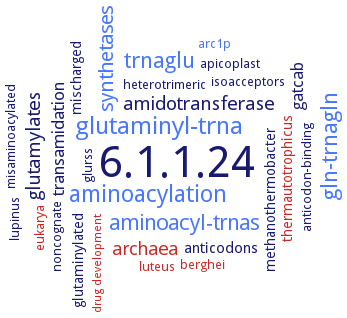6.1.1.24: glutamate-tRNAGln ligase
This is an abbreviated version!
For detailed information about glutamate-tRNAGln ligase, go to the full flat file.

Word Map on EC 6.1.1.24 
-
6.1.1.24
-
glutaminyl-trna
-
aminoacylation
-
gln-trnagln
-
trnaglu
-
aminoacyl-trnas
-
synthetases
-
amidotransferase
-
glutamylates
-
archaea
-
transamidation
-
gatcab
-
anticodons
-
thermautotrophicus
-
glutaminylated
-
methanothermobacter
-
mischarged
-
apicoplast
-
isoacceptors
-
glurss
-
eukarya
-
anticodon-binding
-
berghei
-
heterotrimeric
-
arc1p
-
lupinus
-
luteus
-
misaminoacylated
-
noncognate
-
drug development
- 6.1.1.24
- glutaminyl-trna
- aminoacylation
- gln-trnagln
- trnaglu
- aminoacyl-trnas
- synthetases
-
amidotransferase
-
glutamylates
- archaea
-
transamidation
- gatcab
-
anticodons
- thermautotrophicus
-
glutaminylated
-
methanothermobacter
-
mischarged
- apicoplast
-
isoacceptors
- glurss
- eukarya
-
anticodon-binding
- berghei
-
heterotrimeric
- arc1p
-
lupinus
- luteus
-
misaminoacylated
-
noncognate
- drug development
Reaction
Synonyms
Glu-Q-RS, GluRS, GluRS1, GluRS2, GluRSND, glutamyl-queuosine tRNAAsp synthetase, Glutamyl-tRNA synthetase, GlxRS, ND-GluRS, non-discriminating GluRS, non-discriminating glutamyl-tRNA synthetase, nondiscriminating GluRS, nondiscriminating glutamyl-tRNA synthetase, Pf3D7_1357200, TM1875
ECTree
Advanced search results
Crystallization
Crystallization on EC 6.1.1.24 - glutamate-tRNAGln ligase
Please wait a moment until all data is loaded. This message will disappear when all data is loaded.
GlnRS-tRNAGln complex, 6.6 mg/ml protein in 10 mM PIPES, pH 7.5, 10 mM MgCl2, and 1.8-5.4 mM tRNA. The tRNA/analog solution is then mixed with equal volumes of a 6.3 mg/ml solution of GlnRS, containing 5mM PIPES, pH 7.0, and 5 mM 2-mercaptoethanol, X-ray diffraction structure determination and analysis at 2.6 A resolution
Glu-QRS complexed to Glu, sitting drop vapour diffusion method, mixing of 0.002 ml of protein solution, containing 9.7 mg/ml protein in 20 mM Na-HEPES buffer, pH 7.2, and 50 mM NaCl, with 0.002 ml of reservoir solution containing 0.1 M Mg-acetate and Na-cacodylate buffer, pH 5.5, 0.2 M KCl, 10% polyethylene glycol 8000, and 2 mM L-Glu, a few days, X-ray diffraction structure determination and analysis at 1.5 A resolution
-
full-length ND-GluRS encompassing residues 1-552, including four cysteines and 18 methionine residues, hanging-drop method by mixing 0.001 ml of reservoir buffer containing 50 mM sodium cacodylate, pH 7.0, 50 mM calcium chloride and 8% PEG 6000, with 0.001 ml of protein solution at 20 mg/ml, 20°C, 5 days, X-ray diffraction structure determination and analysis, single-wavelength anomalous dispersion method, using sulfur anomalous dispersion, modelling
-
GluRS in complex with glutamate, hanging drop vapor diffusion at 20°C, 0.003 ml protein solution containing 3 mg/ml protein in 20 mM HEPES, pH 7.9, 20 mM NaCl, 10 mM DTT, 0.25 mM zinc acetate and 0.25 mM MgCl2, is mixed with 0.003 ml reservoir solution containing 740 mM sodium citrate, 140 mM citric acid, pH 5.8, and 10 mM DTT, 1-2 weeks, cryoprotection using 25% v/v of a 50% w/v trehalose solution, X-ray diffraction structure determination and analysis at 2.45 A resolution
Thermosynechococcus vestitus
-
the crystal structure of the Thermotoga maritima ND-GluRS, TM1875, is determined in complex with a Glu-AMP analogue at 2.0 A resolution. ND-GluRS contains a characteristic structure in the connective-peptide domain, which is inserted into the catalytic Rossmann-fold domain
TM1875 in complex with a Glu-AMP analogue, mixing of 0.0018 ml of 15 mg/ml protein in 20 mM Tris-HCl, pH 7.0, containing 5 mM MgCl2, 10 mM 2-mercaptoethanol, 50 mM NaCl, and 1 mM L-glutamylsulfamoyl adenosine, with 0.0018 ml reservoir solution containing 100 mM HEPES-NaOH, pH 7.5, 8% ethylene glycol and 15% PEG 8000, and 0.0004 ml of 30% D-sorbitol, equilibration against 0.5 ml reservoir solution, 20°C, 1 week, X-ray diffraction structure determination and analysis at 2.0 A resolution


 results (
results ( results (
results ( top
top





